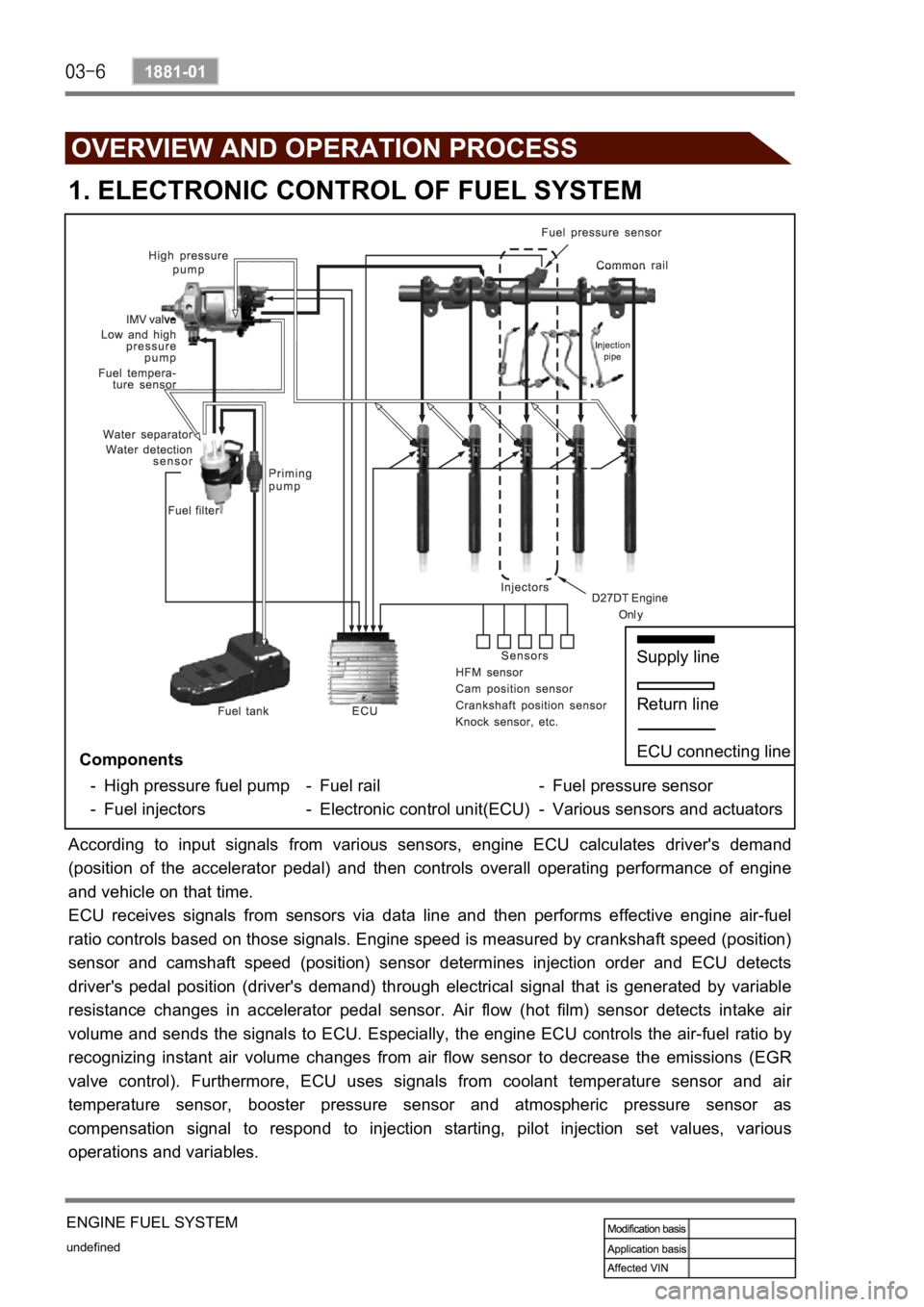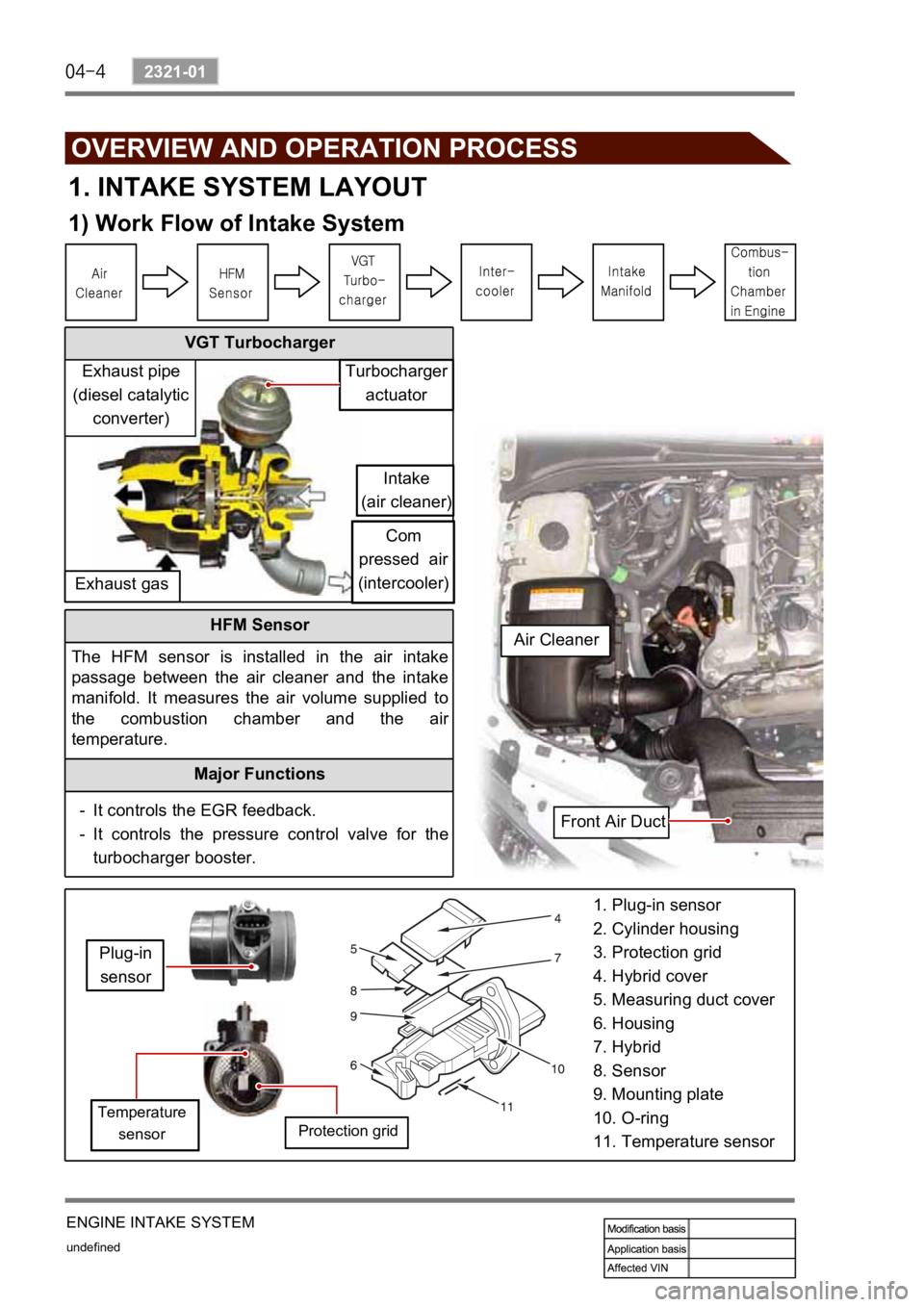egr SSANGYONG KYRON 2010 Service Manual
[x] Cancel search | Manufacturer: SSANGYONG, Model Year: 2010, Model line: KYRON, Model: SSANGYONG KYRON 2010Pages: 650, PDF Size: 74.38 MB
Page 196 of 650

undefined
1881-01
ENGINE FUEL SYSTEM
OVERVIEW AND OPERATION PROCESS
1. ELECTRONIC CONTROL OF FUEL SYSTEM
According to input signals from various sensors, engine ECU calculates driver's demand
(position of the accelerator pedal) and then controls overall operating performance of engine
and vehicle on that time.
ECU receives signals from sensors via data line and then performs effective engine air-fuel
ratio controls based on those signals. Engine speed is measured by crankshaft speed (position)
sensor and camshaft speed (position) sensor determines injection order and ECU detects
driver's pedal position (driver's demand) through electrical signal that is generated by variable
resistance changes in accelerator pedal sensor. Air flow (hot film) sensor detects intake ai
r
volume and sends the signals to ECU. Especially, the engine ECU controls the air-fuel ratio by
recognizing instant air volume changes from air flow sensor to decrease the emissions (EGR
valve control). Furthermore, ECU uses signals from coolant temperature sensor and ai
r
temperature sensor, booster pressure sensor and atmospheric pressure sensor as
compensation signal to respond to injection starting, pilot injection set values, various
operations and variables.Components
High pressure fuel pump
Fuel injectors -
-Fuel rail
Electronic control unit(ECU) -
-Fuel pressure sensor
Various sensors and actuators -
-Supply line
Return line
ECU connecting line
Page 208 of 650

undefined
2321-01
ENGINE INTAKE SYSTEM
VGT Turbocharger
OVERVIEW AND OPERATION PROCESS
1. INTAKE SYSTEM LAYOUT
1) Work Flow of Intake System
HFM Sensor
The HFM sensor is installed in the air intake
passage between the air cleaner and the intake
manifold. It measures the air volume supplied to
the combustion chamber and the ai
r
temperature.
Major Functions
It controls the EGR feedback.
It controls the pressure control valve for the
turbocharger booster. -
-
1. Plug-in sensor
2. Cylinder housing
3. Protection grid
4. Hybrid cover
5. Measuring duct cover
6. Housing
7. Hybrid
8. Sensor
9. Mounting plate
10. O-ring
11. Temperature sensor
Turbocharger
actuator
Intake
(air cleaner)
Com
pressed air
(intercooler)
Exhaust gasExhaust pipe
(diesel catalytic
converter)
Plug-in
sensor
Temperature
sensorProtection grid
Front Air Duct Air Cleaner
Page 209 of 650

ENGINE INTAKE SYSTEM
undefined
2321-01
EGR Valve and Its Location
(* For details, refer to "EGR" section.)
Vacuum Modulator
Turbocharger Intercooler
The charging efficiency may be lowered or the
knocking may happen as the intake air is
heated and the density of air is lowered. The
intercooler is the device which cools the
supercharged air.
Intake
manifoldIntake
air
Exhaust
gasExhaust gasIntake manifold
Vacuum modulator
for turbocharger
actuator
EGR vacuum
modulator
Vacuum
pump EGR
valve
IP interior fuse (RH)
No.63-7.5AEngine ECU
No. 96
Intake Manifold
Intake air
Page 212 of 650

undefined
2321-01
ENGINE INTAKE SYSTEM
1. EGR pipe (RH) 5. Exhaust gas
2. EGR pipe (center) 6. EGR pipe (LH)
3. Coolant emission port 7. Vacuum modulator to the EGR valve
4. Intake air (intercooler)
Intake Manifold
Incoming of intake air and
exhaust gas (Operation o
f
EGR valve) Incoming of intake air (No
operation of EGR valve)
Coolant
emission port
Coolant
emission port The SUS + Rubber coating is applied to the intake manifold gasket to prevent the air leakage
and optimize the sealing effect.
Intake airIntake air
Exhaust gas